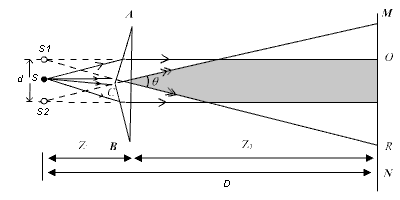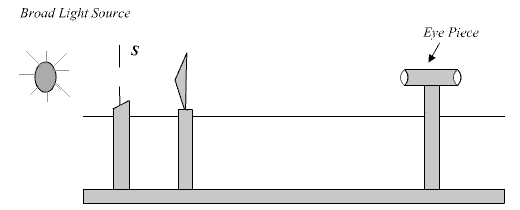SKEDSOFT
System for observing interference phenomenon: Various systems based on these principles have been designed and are used to observe these phenomenon. These systems find several applications in science and engineering such as measurement of wavelength of a light source, the wavelength difference between two closely separated waves, the optical flatness of surfaces, thickness of the film, refractive index of material etc. We shall be discussing some of these systems and their applications in the following sections. The major systems for observing interference phenomenon are as follows.
- Fresnel Biprism
- Newton's ring
- Michelson interferometer
- Fabri-Perot interferometer.
Fresnel Biprism : A freshnel biprism is a thin double prism placed base to base and have very small refracting angle ( ![]() ). This is equivalent to a single prism with one of its angle nearly 179° and other two of
). This is equivalent to a single prism with one of its angle nearly 179° and other two of ![]() each. Here the interference is observed by the division of wave front. Monochromatic light through a narrow slit S falls on biprism ABC , which divides it into two components. One of these component is refracted from portion AC of biprism and appears to come from S1 where the other one refracted through portion BC appears to come from S2. Thus S1 and S2 act as two virtual coherent sources formed from the original source. Light waves arising from S1 and S2 interfere in the shaded region and interference fringes are formed which can be observed by placing a screen MN .
each. Here the interference is observed by the division of wave front. Monochromatic light through a narrow slit S falls on biprism ABC , which divides it into two components. One of these component is refracted from portion AC of biprism and appears to come from S1 where the other one refracted through portion BC appears to come from S2. Thus S1 and S2 act as two virtual coherent sources formed from the original source. Light waves arising from S1 and S2 interfere in the shaded region and interference fringes are formed which can be observed by placing a screen MN .
If d is the separation between the virtual sources S1and S2, Z1 is separation between source S and biprism and Z2 is the separation between biprism and the screen then
Z1 Z2 = D
and fringe width ![]() (1)
(1)
The separation ‘d' between the source can be measured experimently and is described in the following section.

Fig.A: Fresnel's biprism
Fesnel biprism can be used to determine the wavelength of a light source (monochromatic), thickness of a thin transparent sheet/ thin film, refractive index of medium etc. The method of determination is described below. The experiment can easily be done in the laboratory.
Determination of wave length of light and thickness of thin transparent sheet (mica)
Fig- shows the experimental arrangement. Light from monochromatic source is made to fall on a thin slit mounted vertically on a rigid optical bench fitted with a scale. The biprism and the screen (in this case an eye piece) are also mounted vertically. The eye piece can be moved in the plane perpendicular to the axis of bench using a micrometer based translation stage. A convex lens of small focal length is required to determine the separation between the two virtual sources.

Fig.B:Experimental Set-Up: Fresnel Biprism Experiment